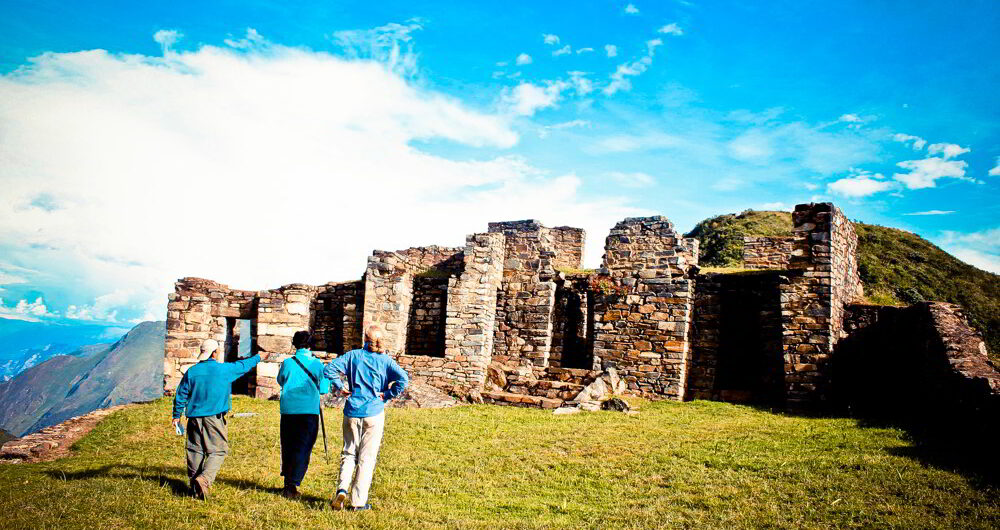Located on a mountain spur, overlooking the Apurimac river on south and the vertical slopes of the Vilcabamba range to the north and east, Inca Choquequirao (3000m) is an awesome site. A private trek to Choquequirao is a unique way to get away from the tourists crowds on a tailormade trip Peru.
Trek to Choquequirao: Lost City of the Incas
It was considered for a century and a half to be “the Lost city of the Incas” a term applied now to Machu Picchu. In fact the likenesses to Machu Picchu are many: much like Machu Picchu it is located on a mountain outcrop overlooking a raging river, Machu Picchu the Urubamba, and Choquequirao the Apurimac. Machu Picchu was probably a sacred place or estate of Inca Pachacutec, and Choquequirao was certainly a place of worship….and each of them are located at opposite sides of Nevado Salcantay (6264m) one of the holiest mountains in the region. Choquequirao is one of the top peru treks in the country for adventurous travellers and an spectacular alternative well worth considering if you’re not doing the inca trail trek.
Peru Luxury Trekking: Trek to Choquequirao: 5D/4N
Choquequirao is much more than an archaeological complex. Its setting is extraordinary: within the space of just a few kilometers, the area is home to such varying ecosystems as glaciers at over 6000m, down to steamy tropical valleys at just 1800m.
The ruins are rarely visited but it is possible to reach the site with a rigorous five day, four night trek to Choquequirao with Aracari travel.
See the full day-by-day itinerary for the Choquequirao trek
History and discovery of Choquequirao
Choquequirao is located 40 kms south west of Machu Picchu as the condor flies: but the mighty peaks of Soray (5428m), Salcantay (6264m) and Yanama (5347m) lie between the two, making access an arduous task.This nightmarish route was taken by the earliest known visitors to the site: French explorer Eugene Sartigues (1834), the French consul in Lima Leonce Angrand (1847), and the great Peruvian artist and cartographer Antonio Raimondi (1867). The earliest known accounts about Choquequirao date to the XVIII century (1710) when prospector Juan Arias Diaz Topete reported three expeditions into a country between the Apurimac and Urubamba rivers during which he found “four ancient towns of heathen times, wholly uninhabited, one named Chuquiquirao which in the Inca language means gold cradle.
Enter Hiram Bingham. The dashing American explorer accessed the site from the south, across the Apurimac gorge where a flimsy wooden bridge had been built by a local expedition a couple of years earlier. It was Hiram Bingham who divulged the existence of Choquequirao to the scientific world, although his discovery of Machu Picchu a couple of years later diverted attention from this site.
Hidden Ruins: About the Site
To this day, Choquequirao remains largely unexcavated. A lot of vegetation has been cleared since the times of early exploration, certainly, but most of buildings and terraces, some say up to 70% continue hidden beneath the undergrowth.
The site as we know it today consists of four main sections: the Curved Terraces, the Lower plaza, he Upper Plaza, and the Truncated hilltop. On accessing the site from the South (Apurimac gorge) the visitor will first encounter the beautifully curved terraces and the Lower Plaza perched above it. It is at the Lower Plaza that most of the buildings are found, forming the “apparent high status sector of the site”1. There is a large hall, three two-storey buildings, a large plaza and several other lesser buildings. The presence of numerous double-jambed doorways suggests the high status of the sector.
The stonework found in Choquequirao is not as fine as that found in some sections of Machu Picchu. Scholars attribute that feature to the quality of the stone available as opposed to evidence of low status. The other sections boast more buildings with double jambed entrance gateways, an enigmatic series of terraces resembling a “giant staircase” and a complex water system. In addition to these four groups, there are other sections of the ruins, a bit further afield such as the Ridge Group and Capuliyoc both below the Curved Terraces. The Ridge Group alone contains as many buildings as the Upper and Lower Plazas combined
Alternative Peru treks
Interested in trekking in Peru? Check out vast range of options for memorable Peru treks to suit all levels and abilities, from lodge-to-lodge trails to luxury camping. As the top Peru specialists, all of our treks are tried and tested to give you personalised recommendations on which to do.
Contact us today for expert, first-hand travel advice on the best trekking options in Peru.

